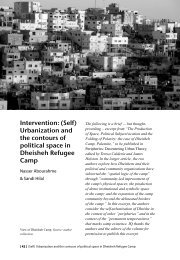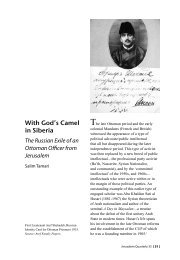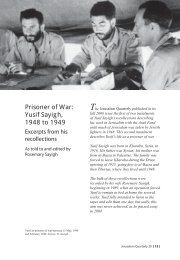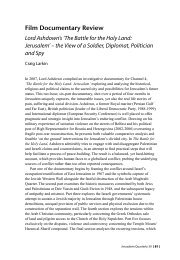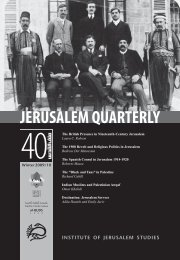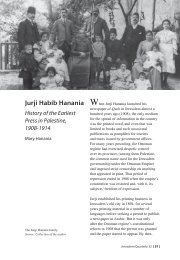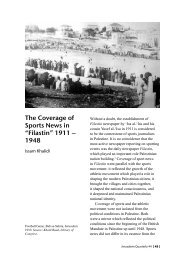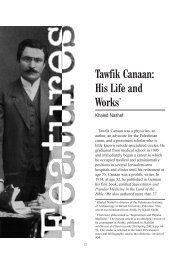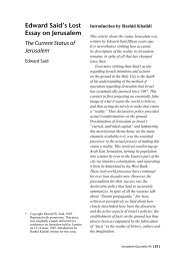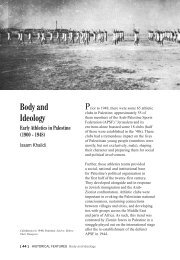PLUNDERING PALESTINE - Jerusalem Quarterly
PLUNDERING PALESTINE - Jerusalem Quarterly
PLUNDERING PALESTINE - Jerusalem Quarterly
You also want an ePaper? Increase the reach of your titles
YUMPU automatically turns print PDFs into web optimized ePapers that Google loves.
But in the midst of war, these hesitations do not affect the enthusiasm and efficiency<br />
of the library staff in carrying out their mission, or their belief that they are engaged<br />
in acts of salvation. And indeed, we must ask: would these books have been preserved<br />
had it not been for the vigorous efforts of these clerks, most of whom were only new<br />
immigrants from central Europe?<br />
The second issue I wish to explore is the library’s conflicted handling of these books:<br />
on the one hand, facilitating a systematic and ongoing separation between the books<br />
and their owners by sorting and cataloguing them into the ‘property’ of the library<br />
and, on the other hand (in a seemingly opposing mindset) keeping the books together<br />
in the National Library’s storerooms marked by a special signature. In the 1950s, the<br />
collected books were marked by the names of their owners whenever possible. In the<br />
1960s, however, the cataloguing system was dramatically altered, erasing the names of<br />
the owners and replacing them with a new signature, “AP” (“Abandoned Property”).<br />
This was a significant change: the books’ connection to their owners was severed, but<br />
the new signature prevented the books from becoming an integral part of the library’s<br />
collections – defacto preserving the Palestinian memory.<br />
Confronting the Past, Silencing Culture<br />
Between December 1947 and September 1949, some 670,000 to 760,000 Palestinians<br />
fled or were expelled from the towns and over 500 villages occupied by the Jews<br />
during the 1948 war. In recent years, following the declassification of most official<br />
political documents of the State of Israel, disclosure of private documents, and<br />
the consolidation of a new critical consciousness, much has been written in Israel<br />
about the war’s catastrophic outcome for the defeated. The works of historians<br />
and sociologists, including Avi Shlaim, Ilan Pappe, Benny Morris, Idit Zartal, and<br />
Baruch Kimmerling, have contributed significantly to this subject by confronting<br />
and exploring the past. We know much more today about the refugees and the way in<br />
which the State of Israel prevented them from returning to their homes. We even know<br />
much about the scope of the refugees’ assets, property, land and factories that were<br />
looted, expropriated and sold, initially to the army and later to the highest bidder. 4<br />
However, little research has been done on the tragic implications of the war for<br />
Palestinian culture. This limited attention to the destruction of Palestinian culture is,<br />
interestingly enough, common to both Israeli and Palestinian discourse.<br />
On 30 April, 1948, renowned educator and Christian Arab writer Khalil Sakakini<br />
fled his home in the Katamon neighbourhood in <strong>Jerusalem</strong> one day after the<br />
neighbourhood was taken over by Haganah forces. His diaries, which have been<br />
partly translated into Hebrew, reveal to Israeli readers a fairly broad picture of life in<br />
Palestine, beginning with the optimism of the 1920s and ending with the miseries of<br />
<strong>Jerusalem</strong> <strong>Quarterly</strong> 33 [ 9 ]


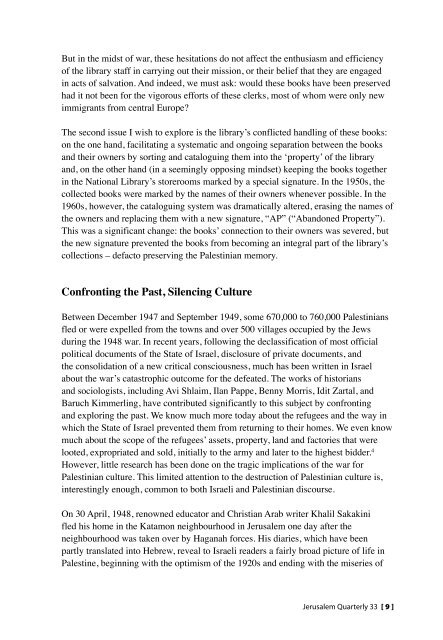
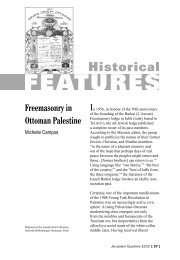
![In Search of Jerusalem Airport [pdf] - Jerusalem Quarterly](https://img.yumpu.com/49007736/1/180x260/in-search-of-jerusalem-airport-pdf-jerusalem-quarterly.jpg?quality=85)
